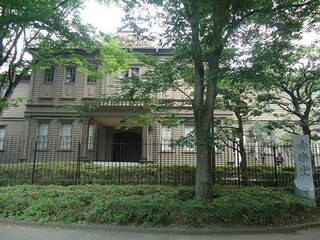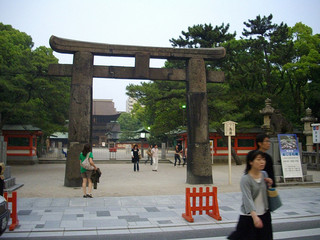Important Cultural Properties
From SamuraiWiki

Sign at Kan'ei-ji in Tokyo, bearing the Bunkachô logo, and identifying the site as containing Important Cultural Properties.
- System Established: 1950
- Japanese: 重要文化財 (juuyou bunkazai)
In 1950, the Japanese government created a new system of cultural heritage, dividing the category of National Treasures - the top tier of sites and objects designated as being of exceptional cultural and historical importance - into an upper tier of National Treasures and a lower tier of Important Cultural Properties.
Important Cultural Properties are more numerous than National Treasures, and are generally considered to be of somewhat less considerable cultural or historical importance. There are currently approximately 12,821[1] objects & structures registered as Important Cultural Properties, identified by the Bunkachô (Agency for Cultural Affairs) logo, a stylized impression of a pair of hands holding up roof tiles.[2]
Selected List of Important Cultural Properties
Hokkaidô
- Former Hokkaido Prefectural Capitol, Sapporo - example of Meiji period red-brick architecture
Miyagi Prefecture
- Sankeiden Shrine at Entsû-in
Ishikawa Prefecture
- Shima teahouse, Higashi Chayagai, Kanazawa - example of geisha house / teahouse machiya architecture
Chiba Prefecture
- Hotta clan mansion, Sakura
- Narita-san Shinshô-ji - Pagoda, Kômyô-dô, Shaka-dô, Niô-mon, Gakudô
Tokyo

Symphony Hall of the Tokyo Music School
- Agency for Cultural Affairs (Bunkachô):
- Saigyô Hôshi gyôjô-e, handscroll painting by Tawaraya Sôtatsu
- Bank of Japan: Old Building
- Eisei Bunko:
- A bronze Buddhist sculpture from the Liu Song dynasty, dated 437
- Haseo sôshi - a Kamakura period painting depicting the story of the Heian period figure Ki no Haseo
- Kuroki neko - a painting of a black cat by Hishida Shunsô, which appeared in the 4th Bunten competition in 1910
- Letter from Emperor Go-Fukakusa to Emperor Fushimi (1292)
- A porcelain jug decorated with peonies, from the Southern Song Dynasty
- Suit of armor (yoroi) said to have been worn by Hosokawa Yoriari in battle in 1358.
- Gokoku-ji:
- Gekkôden
- Hondô
- Holy Resurrection Cathedral
- Idemitsu Museum of Arts:
- Ikegami Honmonji - Pagoda (1608)
- Kan'ei-ji - Eikyûin Mausoleum, Chokugakumon (imperial scroll gate), water basin (suibansha)
- Kiyomizu Kannondô (Ueno) - Main Hall
- Meiji Gakuin University: Imbrie Pavilion (rep. of Meiji Western-style missionary architecture)[5]
- Mitsui Corporation Main Building (Mitsui honkan)
- Nezu Museum:
- Nezu Shrine - shrine buildings
- Seikadô Bunko Art Museum:
- Lan Ying - hanging scroll, "Autumn Landscape in the manner of Wang Meng"[4]
- Zhang Ruitu - hanging scroll painting, "Pine-covered Mountains Rising Through Clouds"[4]
- Sensô-ji Nitenmon gate - downgraded from National Treasure in 1950
- Tokyo Imperial Palace:
- Former Outer Sakurada-mon (gate) of Edo castle
- Former Shimizu-mon (gate) of Edo castle
- Former Tayasu-mon (gate) of Edo castle
- Tokyo National Museum:
- Azekura storehouse of Jûrin-in, Nara
- Gate of the Inshû-Ikeda Residence
- Kyôgen mask of Ebisu, from the Ôkura school[1]
- Liang Kai - hanging scroll painting of Li Bai[4]
- Lu Ji - set of four hanging scrolls, "Birds and Flowers of the Four Seasons"[4]
- Ma Yuan (attr.) - hanging scroll, "The Priest Dongshan Wading Across a Stream"[4]
- Ogata Kôrin - Fûjin/Raijin screen paintings
- Painting on Zen Enlightenment, panel paintings from hôjô of Daisen-in, attr. Kanô Motonobu
- Sakai Hôitsu - Screen paintings of Spring and Autumn Flowering Plants
- Shi Ke (attr.) - pair of hanging scrolls, "Two Patriarchs Harmonizing Their Minds"[4]
- Sun Junze (attr.) - hanging scroll landscape[4]
- Unkoku Tôgan - landscape, pair of folding screen paintings[2]
- Various 16th-17th century artworks and artifacts related to the Society of Jesus and Japanese Christianity.[3]
- Yan Hui (attr.) - pair of hanging scroll paintings of Hanshan and Shide[4]
- Zhu Duan - hanging scroll, "Solitary Angler on a Winter River"[4]
- Tokyo University of the Arts:
- Symphony Hall of the Tokyo Music School
- Hibo Kannon by Kanô Hôgai - pioneering work of Nihonga
- Ueno Tôshôgû: Main Hall, Karamon gate, other buildings; stone torii; and fifty copper lanterns
- University of Tokyo:
- Akamon ("Red Gate"), former gate of the Kaga Edo mansion (Hongô campus)
- Former Maeda Family Main Residence (Komaba campus)
- Diary of Uwai Kakken (held at Shiryôhensanjo)
- Waseda University: Ôkuma Auditorium
Kanagawa Prefecture
- Kenchô-ji Butsuden (main Buddha hall)
- Sankeien:
- Gekkaden, formerly of Fushimi castle, built 1603 by Tokugawa Ieyasu
- Pagoda - formerly of Tômyô-ji, Muromachi period, oldest pagoda in the Kantô
- Rinshunkaku - summer home for Kishû Tokugawa family head Tokugawa Yorinobu, 1649, Wakayama
- Shunsôrô tearoom built by Oda Urakusai
- Former main hall of Tômyô-ji, Muromachi period, Kyoto
- Sôgen-ji, Twelve Heavenly Generals (Kamakura period sculptures, representative of Unkei's style)
- Former Yokohama Specie Bank Headquarters - example of Meiji period architecture
Shizuoka Prefecture
- Kunouzan Toshogu clock, held by the Kunouzan Toshogu Museum
Aichi Prefecture

The southeast corner tower at Nagoya castle
- Nagoya castle - the three remaining corner towers, of an original eleven
- Tokugawa Art Museum:
Shiga Prefecture
- Hikone castle - various buildings, including Ninomaru Sawaguchitamon-yagura and stables (umaya). Main tenshu is a National Treasure.
- Hôshû-kai, Takatsuki Town - various documents and paintings associated with Amenomori Hôshû[6]
Nara Prefecture
- Kasuga Shrine:
- Kôfuku-ji Numerous sculptures, incl. Seated Amida Nyôrai sculpture - Kamakura period
Kyoto Prefecture

Windows of the upper story of Clarke Memorial Hall at Dôshisha University

Pagoda at Ninna-ji, Kyoto
- Byôdô-in - Yôrin'an shoin, moved to the Byôdô-in from Fushimi castle in 1601
- Clarke Memorial Hall at Dôshisha University
- Daitoku-ji Shinju-an - various paintings, works of calligraphy, etc. including works of calligraphy by Daitô Kokushi.
- Former Kyoto Prefectural Headquarters (1904)
- Ginkaku-ji - entire complex; includes two buildings designated as National Treasures.
- Honpô-ji - two portraits by Hasegawa Tôhaku of Buddhist priests
- Manpuku-ji - various buildings
- Nanzen-ji sub-temple Tenju-an:
- 32 fusuma paintings by Hasegawa Tôhaku, self-portrait of Daimin-kokushi, self-portrait of Shôichi-kokushi, portrait of the priest Heiden, and two portraits of Hosokawa Yûsai and his wife
- Ninna-ji:
- Sanbô-in - Gienjugô nikki
- Shimogamo Shrine - 53 various objects.
- Zenrin-ji:
- Mikaeri Amida sculpture
- Painting of sixteen Arhats (ink & colors on silk, Kamakura period, Important Cultural Property)
- Painting of the raging sea on gilded paper, by Hasegawa Tôhaku (hatô-zu)
- Painting of Shaka Trinity by Kanô Motonobu (colors on paper)
- Painting of Shaka and Ten Disciples, attr. Zhang Sigong (color on silk)
- Painting of Amida and Twenty-Five Bodhisattvas raigô
- Painting of Amida Trinity (Kamakura period)
- Painting of Buddha entering Nirvana (nehanzu, ink and colors on paper)
- Painting of Yakushi nyorai (ink and colors on silk)
- Painting of Shaka and 16 good gods (Shaka 16 zenjin-zô)
- Painting of Ten Worlds (colors on silk)
- Painted door of 25 bodhisattvas raigô
- Reliquary
- Taima Mandala (1262)
- Taima Mandala (c. 1213-1218)
- Yûtsû nenbutsu engi by Tosa Mitsunobu (colors on silk)
- Yûtsû nenbutsu engi kanjinchô (colors on paper)
Osaka Prefecture
- Osaka City Museum of Fine Arts:
- Dong Qichang - handscroll paining, "The Pan'gu Farewell"[4]
- Wang Wei (attr.) - handscroll painting, "Fu Sheng Transmitting the Classic"[4]
Okayama Prefecture
Hiroshima Prefecture

The Ôta family house (left) and Chôsôtei (right) in Tomonoura
- Fushimi yagura (tower) and Sujigane-gomon (gate) at Fukuyama castle.
- Ôta family house (former Nakamura family house) and Chôsôtei lodgings in Tomonoura; merchant home where Ryukyuan embassies to Edo, various daimyô, and kuge stayed at times.
Kôchi Prefecture
- Kôchi castle: a number of buildings, including the tenshu, Kaitokukan (shoin-zukuri style daimyô residence), East and West tamon yagura, Kokutetsu-mon, Kurogane-mon, and Roka-mon gates.
Fukuoka Prefecture
- Ichi-no-torii at Hakozaki Shrine, 1609
- Letters from Nguyen Hoang to Toyotomi Hideyoshi (1591) and Tokugawa Ieyasu (1601), Kyushu National Museum
Kumamoto Prefecture
- Lord's cabin (goza/yakata) of Hosokawa clan ship Naminashi Maru, Kumamoto castle, 1839
Kagoshima Prefecture
- Three bronze mirrors held at Nitta Hachiman Shrine, Satsumasendai
- Main Building (honkan) at Shôkoshûseikan, 1865
- Photograph of Shimazu Nariakira by Ichiki Shirô, 1857, Museum of the Meiji Restoration
- Red-threaded suit of armor and helmet of Shimazu Tadahisa, Tsurugane Shrine
- Tachi by Bizen-no-kuni Jûunji, Tsurugane Shrine
Okinawa Prefecture
- Aragaki house and agari-nu-gama pottery kilns in Tsuboya, Naha
- Bridge of Nations Bell - collection of the Okinawa Prefectural Museum
- Engaku-ji - named a National Treasure in 1933; destroyed in 1945. Rebuilt gates and bridge named Important Cultural Property in 1975. Former temple bell (cast c. 1495-1496), and a 1697 recreation of that bell both survive and have both been designated.
- Collection of Kamakura Yoshitarô's photographs from his survey of Okinawan arts; held by Okinawa Prefectural University of the Arts.
- Magiri-zu maps, held by Okinawa Prefectural Museum
- Mekaru tombs group site (incl. Izena dunchi tomb, near Shintoshin Park, Naha)
- Nakamura House in Nakagusuku Village
- Sôgen-ji - designated a National Treasure in 1933; destroyed in 1945. Surviving stone walls & gates are today an Important Cultural Property.
References
- Gallery labels and explanatory plaques at various sites.
- Pamphlets available on-site.
- ↑ "Cultural Properties for Future Generations," Pamphlet, Agency of Cultural Affairs (2013), 2.
- ↑ Hyung-il Pai, AAS Roundtable, "Who Moved My Masterpiece?...Cultural Heritage of Kyoto," Association for Asian Studies annual conference, San Diego, March 23 2013.
- ↑ While the Freer piece seen here is permanently housed outside of Japan, and is therefore not an Important Cultural Property, an earlier version of the same work, held today by the Tokyo University of the Arts, does bear that designation.
- ↑ 4.00 4.01 4.02 4.03 4.04 4.05 4.06 4.07 4.08 4.09 4.10 4.11 4.12 4.13 Exhibition checklist, "Chinese Paintings from Japanese Collections," LACMA, May 10 2014.
- ↑ Imbrie Pavilion, Meiji Gakuin University website.
- ↑ Chôsen tsûshinshi to Okayama, Okayama Prefectural Museum (2007), 67-68.
- ↑ Chôsen tsûshinshi to Okayama, 34.



